10 “Original” Remakes
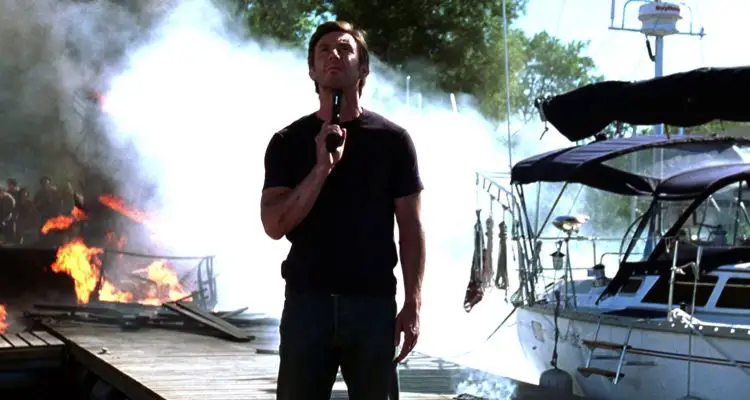
Massive film lover. Whether it's classic, contemporary, foreign, domestic, art,…
Since the market is so flooded with remakes and reboots it can be difficult to sift through the titles to find original material. Sometimes a film can take on new life with a modern makeover. Brian DePalama‘s Scarface is a good example. Howard Hawks’ 1932 original indeed is an expertly made classic, but I’m sure more people remember Al Pacino yelling “Say hello to my little friend!” than anything else.
What makes a remake good or bad? Other pictures carry on without people knowing it was inspired by another film. When someone asks if you like a movie a lot of the times you end up saying “well, which one, the original or the remake?”. This list is a collection of films that take have a life of their own beyond their predecessors. Films that equal, rival, or evolve on their own terms beyond the trappings of a mere remake.
10. Reservoir Dogs (1992) VS. City on Fire (1987)

Reservoir Dogs was Quentin Tarantino‘s directorial debut, and a first-rate feature film from America’s premier director. Roger Ebert once said “Even Martin Scorsese and Francis Coppola had a warm up period..” and he indeed has a great point. Reservoir Dogs was hailed as an original, stylish, and fresh new film that introduced the world to Quentin Tarintino. Now with all the praise, awards, and reviews, isn’t it strange that this film is actually a remake?
Like many films before and after, Tarantino‘s inspiration comes from Hong Kong, and this film would be City on Fire. A finely executed crime film from acclaimed director Ringo Lam, starring Chow Yun Fat, and Danny Lee. The story focuses on a Triad gang who unknowingly recruit an undercover cop into their syndicate. After a botched jewel heist that turns into a blood bath they suspect someone in the gang is an informant. But which one could it be? This of course escalates into a bloody standoff that makes us question the merits of loyalty and betrayal. Sound familiar? However, with all these similarities what is the difference between these two films? Well, everything!
City on Fire is a great movie. It’s a dynamic, multi-layered crime film, with lots of action and a solid story at its center. However, Reservoir Dogs is an example of what Tarantino does best. Taking material he loves, and running with it, making the film his own every step of the way. The nonlinear structure, dialogue, violence, humor, and referential pop culture dialogue is what makes the film so much fun. And it’s a theme we would come to see in all of his films. Any other filmmaker would be branded a “copycat” or “imitator” but not when your movies became the paramount voice of a generation. Having said all that, why does City on Fire go on, largely unacknowledged?
The solution for that is to go out and see this movie! If you want to satisfy your curiosity, or just see a great gangster film from Hong Kong, City on Fire is the way to go.
9. Dawn of the Dead (2004) VS. Dawn of the Dead
(1978)

When Zack Snyder’s Dawn of the Dead came out, the wave of classic horror remakes was at its highest. After the The Ring, The Grudge, and for fans of Tobe Hoopers original, The Texas Chainsaw Massacre (2003) was pretty much offensive. So, when it was announced that Dawn of the Dead was next in line, naturally fans of the original had their trepidations.
By the opening credits, after that turbulent opening scene those trepidations went away. The use of Johnny Cash over the credits, the news footage genuinely amplifying the tone of a worldwide epidemic, and the cast, (Sarah Polley, Vhing Rhames and Mekhi Phifer are great) all add up just right.
The film follows original director George A. Romero‘s template, maintains the story, adding some characters, while making the leads more dimensional. Furthermore, Snyder remembered the sense of humor and balances it in his version of the film just as well as Romero had in 1976. The violence is turned up, but unlike the flood of horror films being churned out at the time, Dawn of the Dead refrains from being gratuitous, and manages to infuse the film with graphic violence as well as some well observed black humor. The celebrity look alike, rooftop sniping is a good example. An important addendum is Snyder’s endearing nods to Romero‘s film. Throughout the movie, cast members from the 1976 version appear in cleverly placed cameos as television personalities, just as John Landis was the eye-patch-sporting raconteur the first time around.
This version of Dawn of the Dead isn’t trying “outdo” the original, it exists as its own movie with the same story, in a new decade with new characters, and new politics. Most importantly, it’s a new horror movie, that has the goods to stand on its own two feet. If you consider yourself a purist of horror films and avoid remakes, this one should be the one exception to that rule. Let your guard down just this once, and you might find yourself thoroughly entertained.
8. Sorcerer (1977) VS. The Wages of Fear (1954)
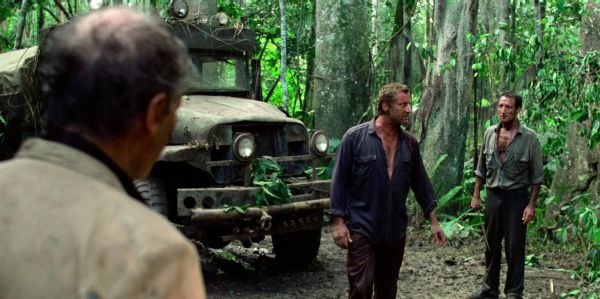
Although William Friedkin‘s inspiration for Sorcerer, Henri-Georges Clozout‘s The Wages of Fear is frequently observed as the superior film. Nevertheless, Sorcerer is a large scale, high stakes adventure that looks, sounds, and feels unlike any other film. However, a problematic production, a budget that spun out of control and a poorly timed theatrical release put the Friedkin‘s passion project in a compromising position that lead to its failure at the box office.
Sorcerer is a dynamic film. Loaded with eye-popping visuals, a pulsating score from Tangerine Dream, and some staggering scenes of suspense. The very title of the movie evokes an air of mysticism that is present throughout the course of the film. What Henri-Georges Clozout achieved in raw suspense, (and there’s plenty of it in both films) Friedkin exchanges for visual rhetoric. Sorcerer is a meticulously crafted film; the eye for design pays of.
A low-key cast, alongside Roy Scheider who’s one part Humphrey Bogart from The Treasure of the Sierra Madre, part beat up everyman (the role was originally offered to Steve McQueen who would later regret turning it down), is perfect. His descent into madness as the nerve fraying journey whittles away his senses is frightening and exciting. The film unveils itself like a fever dream, and its journey is jarring and incredible.
Sorcerer had, until this year, little to no life on home video. It’s now available on BluRay with a great collection of production images and excerpts from the directors latest memoir “The Friedkin Connection“. Don’t buy into the hype of all the negativity that surrounds this movie and let Sorcerer cast it’s spell on you.
7. The Departed (2006) VS. Infernal Affairs (2002)
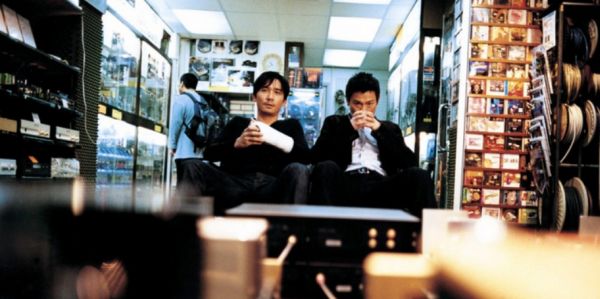
The Departed was based on a popular Hong Kong movie Infernal Affairs. Martin Scorsese’s film was massively successful, bringing the famed director a Best Picture Oscar. It’s an ambitious modernized gangster film that entertains as well as reflects our anxieties about the modern world of technology, as well as life in post 9/11 society.
The Hong Kong film Infernal Affairs was a great success in China during a time when the once huge movie industry of Hong Kong was in decline. Infernal Affairs spawned two sequels and a spin-off film, as well as Japanese and Korean remakes. Directed by famed actor/director Andrew Lau and writer/director Alan Mak, Infernal Affairs has the same story that would be adopted by Martin Scorsese later on in 2006. A cop infiltrates a gang, and a gangster infiltrates the cops.
The school on “which is better” appear to be split down the middle. Scorsese drew on the themes of loyalty and identity explored in Lau’s film and punctuates it with an exclamation point. He hit a new level with The Departed, both in style and narrative complexity. The visual flourishes embraced old and new cinematic tricks. The film investigated the morality of both gangsters and police with an equally detailed eye.
The use of cell phones, and texting was also a disquieting reminder of the power we place in our technology. Scorsese felt that these devices and the information they send are just as dangerous as any other weapon. The transplantation of his characters out of his comfort zone, from New York to Boston, with gangsters that are Irish American instead of Italian, was a welcome change of pace.
The cast is great; Scorsese incorporated a younger generation of actors such as Leonardo DiCaprio, Matt Damon, Mark Wahlberg and Vera Farmiga, as well as some seasoned pros such as Jack Nicholson, Martin Sheen, Alec Baldwin and Ray Winstone.
Interestingly, Scorsese has stated that he refrained from seeing the movie Infernal Affairs until The Departed finished. However, if it hadn’t been for Lau’s Infernal Affairs it’s almost a guarantee we wouldn’t be talking about The Departed. You could quibble over which is better, or just be grateful you have both films to enjoy?
6. Nosferatu The Vampyre (1979) VS. Nosferatu
(1922)

Werner Herzog is a director who has consistently reinvented himself and the movies he sets out to make. You’d think that someone who cut their teeth in the world of documentaries and social realism would feel out of their element working with a story that’s so pivotal in the world of horror, but Herzog was fascinated with characters whose true stories are beyond belief. What better character to investigate than one whose tale is pure fantasy? Herzog‘s interpretation of the Dracula character through the Nosferatu model was an amazingly unique and brilliant film. It’s one of those movies that almost doesn’t qualify as a “remake” since it’s such an original piece of work.
Herzog’s Nosferatu The Vampyre fits in a special place in his career, and in the lengthy array of vampire films. The Silent German films from the Weimar era were immensely influential, and F.W. Murnau (director of the original Nosferatu) was the premier name among the filmmakers to emerge from that period. Herzog‘s body of work is a big part of the German New Wave movement along with luminaries such as Wim Wenders, and Rainer Fassbinder. His interpretation of Nosferatu at this point was just as vital as ever.
“If his (Murnau) Nosferatu is a genre film then mine inevitably is one too. In many ways, for me, this film was the last chapter of the vital process ‘re-legitimization’ of German culture that’s been going for some years”.- Herzog in his interview with Paul Cronin, from his book ‘Herzog on Herzog’
Klaus Kinski was perfectly cast as the count and to great effect; his sickly portrayal of the count was pitch perfect. As a menace, his deathly aura could be the cause of multiple plague contracted deaths. Isabelle Adjani played a beautiful and more proactive Lucy Harker.
From start to finish Herzog’s Nosferatu the Vampyre is a treat. It’s genuinely scary at times, and genuinely funny at others. His feel for realism brings credibility to very incredible material. Although Murnau’s original silent film is great, Herzog took a character and a story and with his best leading man made a wonderfully atmospheric and chilling original. The silent classics of horror will always have a place in cinematic history, and Nosferatu is one of the best. But you have to hand it Werner Herzog for his achievement with Nosferatu The Vampyre.
5. 3:10 to Yuma (2007) VS. 3:10 to Yuma (1957)
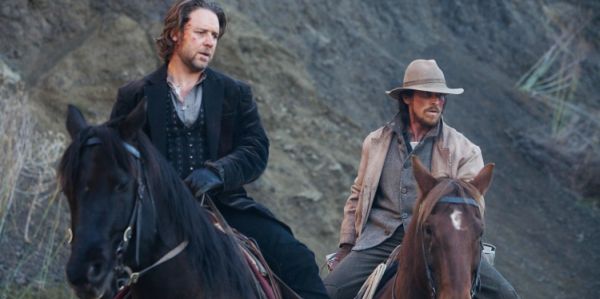
Delmer Daves’ 1954 film 3:10 to Yuma is one of many great Hollywood westerns of the 1950’s. After the western experienced its heyday in the 50’s, through the 60’s the genre underwent a few makeovers. Sergio Leone launched the spaghetti western with his own remake of Yojimbo as A Fistful of Dollars. Sam Peckinpah‘s bloody revisionist epics gave way to a new style of gunslinging. Since then, the public interest in the genre is only piqued every few years.
In 2007 James Mangold aroused the public’s attention back into westerns once again. Taking the story of the original, a short story written by Elmore Leonard, he made an expanded, and elaborate version of the film. What Mangold did with 3:10 To Yuma is what every smart director should remember when they handle the material of another filmmaker: keep in with the tone of the source, and make it your own.
Mangold‘s revision of the west was brilliantly executed. It’s rough, it’s dirty, the people are mean, the land is harsh and the lines between good and evil are thin at best. Russell Crowe was brilliant as outlaw Ben Wade. His interpretation of the character might even exceed Glen Ford‘s performance in the original movie. Wade is a malevolent, and complex outlaw; he’ll shoot you a smile before filling you with lead. Christian Bale proved once again he’s a great actor. He played Dan Evans, a down on his luck farmer; with one leg, and no money, he’ll risk his life to get the reward.
James Mangold achieved what few directors have in the past. Make a film that might not equal the original but actually surpass it. Delmer Daves 3:10 to Yuma is a classic in its own right, and should be seen before this remake. It will enhance your appreciation for the genre, and serve as an example of what can be achieved with a creative, and original vision.
4. The Magnificent Seven (1960) VS. The Seven
Samurai (1954)

Another famous Western that has a lot of relatives in the family tree of movies: The Magnificent Seven. One of the most iconic and influential westerns. The chronology of this movies genesis is a great example of the extensive influence of film.
John Sturges’ The Magnificent Seven is indeed a remake of Akira Kurosawa‘s The Seven Samurai. Kurosawa, a prolific filmmaker both in his native Japan as well as the United States, was profoundly influenced by the films of John Ford, especially his westerns. So, the result is a Western, that is a remake of a samurai film, which was influenced by classic American Westerns. This is exactly why the whole concept of remakes can be so interesting.
The Magnificent Seven is notable for it’s magnificent casting. The film was successful, though not just from a commercial stand point. It launched the careers of Yul Brynner, Steve McQueen, Horst Bucholz, James Coburn, Robert Vaughn, Charles Bronson, and the great Eli Wallach. With the addition of Wallach the film would be better served if it was called The Magnificent Eight. Each cast member had a distinctive trait, and drew inspiration from the characters in Kurosawa‘s original. It follows the steps of the original: the planning, the recruiting of the hired guns, the skirmishes, the duality of heroism are presented with an equally effective delivery.
The story of roaming gun fighters, fighting for the lives of a village of poor Mexican villagers for some reason didn’t resonate with American audiences at first. After it received positive reviews abroad, it was re-marketed and grew to be a classic. If a film as legendary as this went unnoticed, it can only make someone wonder if some other great films from the studio era slipped by the public’s imagination?
3. The Fly (1986) VS. The Fly (1958)

In 1958 Kurt Neuman directed a film starring Vincent Price, Al Hedison, and Patricia Owens. That film was The Fly. The Fly has some notoriety as a classic sci-fi/horror movie with the classic “Help Me!” line at the end. But in 1986 David Cronenberg, who had made a name for himself as the creator of his distinctive “body horror” films, signed to direct a remake of The Fly. With trendsetting movies like The Brood and Scanners to his credit there was no way to anticipate what he was going to do with this picture.
The Fly (1986) would be one of the most daring, grotesque, and successful films of Cronenberg‘s career at that point. The story is that of a scientist, whose DNA is crossed with a fly, while experimenting with his telepod invention. What ensues is an up close and personal look at Sethaniel Brundle’s gradual mutation and disintegration as his human DNA is breaking down, transforming into a hybrid mutant he refers to as “Brundlefly”.
After the success of The Dead Zone, The Fly would be a Cronenberg‘s second adaptation. The first draft of the screenplay had a lot of bodily oriented characteristics that, of course, caught his attention. What interested the director was,
“How does this man deal with his disease: rationalize it? Articulate it?” – from ‘Cronenberg on Cronenberg’
Jeff Goldblum’s interpretation of the Seth Brundle character has to be the most upbeat victim in the history of horror films. His rapid deterioration not only fascinates him, but consumes him just as much as the disease is consuming his body. Seth Brundle can also be seen as a reflection of the filmmaker as Cronenberg‘s fascination with the flesh is a constant throughout his films. The Fly is the epitome of the directors own sub genre of “Body Horror”.
The Fly may be gruesome, but the Oscar-winning special effects by Chris Walas and Stephan Dupuis are mesmerizing. The material is treated in a serious and straight forward manner: the premise of a man turning into a fly could be silly, but Cronenberg makes it his own, every step of the way.
2. A Woman, a Gun and a Noodle Shop (2009) VS. Blood Simple (1984)
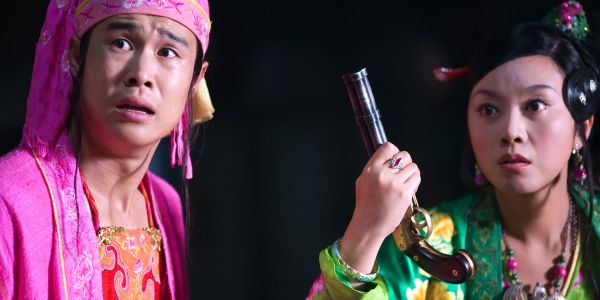
What could a Texas based saloon keeper, his wife’s affair with his employee, and a murder plot gone awry have to do with nineteenth century China? Well, absolutely nothing, if you aren’t familiar with the Coen Brothers debut feature Blood Simple. The connection to nineteenth century China? We have director Zhang Yimou to thank for that.
A Woman, A Gun, and a Noodle Shop is Zhang Yimou‘s remake of Joel and Ethan Coen’s 1984 feature Blood Simple, on the surface that might seem strange. Zhang Yimou, a director known for his wildly stylized, gravity defying wuxia pictures such as Hero, and House of Flying Daggers. He’s equally adept crafting breathtakingly composed period dramas such as Raise the Red Lantern, and Red Sorghum.
Transplanting the murky noir tale of Blood Simple to China of the 1800’s might seem like a daring move for a filmmaker who makes such colorful and expressive films. Yet, his realization of the original story works wonderfully in A Woman, A Gun And A Noodle Shop. Another daring move on Yimou‘s part was combining the weighty material with an oddly suitable infusion of slapstick comedy. What’s great about this film is that each and every step of the story from Blood Simple was utilized. Of course, some elements of Blood Simple were remolded, not just to fit the setting, but to work in concert with the director’s bravura visual aesthetic. Memorable scenes include a noodle-making session with bright flying garments in Yimou‘s whimsical fashion.
The emphasis on “The Gun” as a part of the title is central to the movie. Since it took place over two hundred years ago the weapon is a newly fangled device and play prominently in the film. The sleazy detective Loren Visser, played by Coen regular M. Emmet Walsh, is replaced by a stone faced, armor-clad detective called Zhang. In contrast to Walsh‘s smart-alecky Texan, Zhang is nothing but business, recalling the stoicism of many movie heroes. In the context of Chinese cinema the expressionless loner is quite often the hero. The wife Yan Ni, has more gravitas than Francis McDormand‘s Abby character.
Many people don’t really know what to make of this remake, since it seems to fall all over the place. However, if one is interested in seeing something you have never seen before, A Woman, A Gun And A Noodle Shop is an original remake indeed.
1. The Thing (1982) VS. The Thing From Another
World (1951)
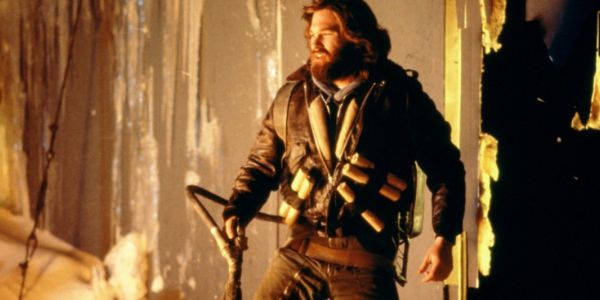
Almost every filmmaker follows in the footsteps of a creative influence they emulate. Brian DePalma is clearly a fan of Alfred Hitchc*ck‘s visual style, Akira Kurosawa loves the films of John Ford, and Quentin Tarintino is influenced by..well, everyone? But John Carpenter is a filmmaker whose work was profoundly influenced the cinema of Howard Hawks.
Howard Hawks‘ The Thing From Another World can be seen in his classic 1978 film Halloween in the background on the television. You can also see Hawks’ influence in Carpenter‘s fist debut feature Assault on Precinct 13, which is loosely a remake of his 1954 film Rio Bravo. By 1982 Carpenter had made a name for himself with his beautifully uncomplicated horror films. His low-budget Halloween kicked off the genre of the slasher film wile repudiating its values at the same time. Four years later, he would once more revisit the material of his idol.
John Carpenter‘s The Thing is a movement that counters the style of his previous films. In Halloween, you’re fooled into thinking you’ve seen a gory slasher film, when in fact, there isn’t a drop of blood throughout the entire film. The Thing was a creative turn for John Carpenter: instead of frightening people with a sense of the unknown and suspenseful implication, in the The Thing you see everything! The monster isn’t a faceless slasher, it’s a mutant severed head that sprouts legs, a chest cavity that opens up like a mouth and bites arms off; it’s a plethora of imaginative, and terrifying monstrous creations.
One thing that makes The Thing so fascinating is that with all the gruesome effects it carries a weighty tone of paranoia and psychosis. The other commodity that makes The Thing so great, and lasts in the mind of it’s viewers, are the horrifying special effects. It carries an essence of what a mutant virus could form (or deform) into. No two monsters look alike, they maintain the look of their host, while they transform into ghastly mutations.
The Thing was greeted with hostile reviews from critics all over. Since its release on home video, horror fans all over have taken to the film. IMDb has a user rating of 8.2 out of 10, Rotten Tomatoes 80% fresh rating, and if you ask a casual horror buff about The Thing, it usually ranks among their favorites. While it performed poorly at the box office, droves of people love the film now. Who’s to say who’s wrong or who’s right?
Some remakes are lazily realized, hand-me-down reiterations that betray an original vision. Other remakes can be stand alone movies. Some directors see the potential for widening the scope of their movies, like the way James Mangold sculpted his own version of 3:10 to Yuma. Other filmmakers use genre and historical context to transform a film into something that fits with their own sense of familiarity. John Sturges transplanted Kurosawa‘s epic film Seven Samurai into his very own adventure. The result was entertaining, with the emotional depth that made Akira Kurosawa‘s original so poignant.
A remake doesn’t have to be a mere retread. Thanks to the ingenuity of some respectful directors these movies are in a league of their own. This proves that old ideas can be new classics.
What are some of your favorite remakes? Do you agree that remakes can be as original as its source material?
(top image source: Dawn of the Dead (2004) – Universal Pictures)
Does content like this matter to you?
Become a Member and support film journalism. Unlock access to all of Film Inquiry`s great articles. Join a community of like-minded readers who are passionate about cinema - get access to our private members Network, give back to independent filmmakers, and more.
Massive film lover. Whether it's classic, contemporary, foreign, domestic, art, or entertainment; movies of every kind have something to say. And there is something to say about every movie.












